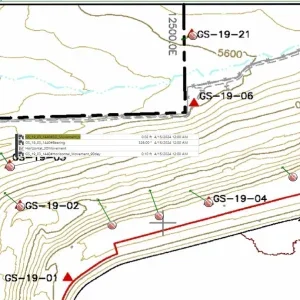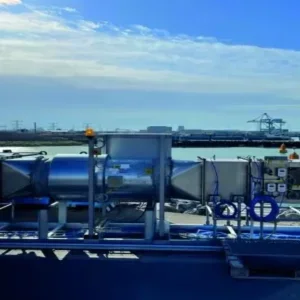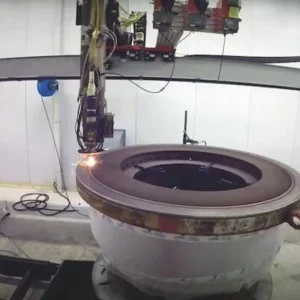The analytical power and design flexibility offered by the Finite Element Method (FEM) is all too readily masked from the first time user, by its inherent complexity. The steep learning curve can appear daunting when the method is first encountered, and FEM needs to be sensitively introduced, with carefully graded examples if students are not to be put off the subject completely. Partly the problem lies with the available software, which until recently had been based around UNIX and workstation protocols. With the advent of Windows NT, cheaper memory and faster and larger hard disks, some programmes are beginning to have a more user-friendly look and feel, and this can be used to good effect when teaching the subject to undergraduates.
At one extreme the presentation has involved students ploughing through pages and pages of mathematics before being exposed to any meaningful examples. Even then, the data entry has often been less than ideal, necessitating laborious button pressing and correction of frequent typing errors because the software lacked a good graphical interface and modelling tools. In other cases, the treatment of the subject has involved nothing more than the presentation of a slide show, with no hands-on experimentation allowed.
Strategic moves
In an effort to avoid both of these extremes, the author has developed a strategy which he believes enables students to experience for themselves how beneficial FEM can be, whilst at the same time grounding them in how to avoid the many pitfalls and dangers. In essence, the strategy uses the following guiding principles:
• Use LUSAS, a commercial package that is Windows NT based.
• Use open-ended examples.
• Get students working in groups to develop a team-working approach to problem solving.
• Concentrate on the development of quality assurance processes and good practice rather than theory.
• Theory is only introduced when deemed necessary to a correct understanding of how to apply the method to real situations.
• Investigate the parameters which determine an appropriate balance between accuracy, efficiency and cost-effectiveness.
• Develop an understanding of when and how to use FEM in a commercial environment.
Students are first given some training in the use of LUSAS, which involves guiding them through a simple elastic example that illustrates many of the package’s features. This can normally be completed in about two hours of hands-on practice.
Referring to an example that is actually used in the author’s teaching will best illustrate the application of these principles. Consider the following seepage problem (Figure 1).
Students are asked to investigate the following:
• a) The different ways in which the geometry of the model can be constructed
• b) How to choose the best element type
• c) The influence of mesh topology upon accuracy and efficiency
• d) Boundary conditions, e.g., how far to right and left the soil should be modelled
• e) The effect of changing the cut-off wall depth
• f) How best to interpret and present the results
• g) How the FEM answer can be checked
• h) Influence of flow rates on soil stability
Students are asked to think about what further analysis they would recommend and to reflect upon the experience they have gained.
Students are also told that they will not be able to answer all of these questions by working on their own. They must work collaboratively and share their results if they are to complete the assignment successfully. In addition, students are encouraged to go to the library and read relevant articles on this area of study.
Although there is no single ‘correct’ answer, the following discussion shows how a typical analysis might proceed.
LUSAS is a highly advanced modelling tool and affords the engineer with a plethora of tools that allow almost any configuration to be generated.
However, it is always best to start with as simple a concept as possible, and the following, simple arrangement of surfaces (Figure 2) will probably prove to be the starting point for most students.
This subdivision of the model domain into rectangles is the simplest way of building the necessary boundary geometry but has the drawback that the mesh is constrained by the lines forming the surfaces. LUSAS can control the mesh density in a number of ways, but the simplest is to specify either the number of elements or the element length along the lines bounding the surface. If the latter is used and the element length set to 1.5m, the following regular mesh results (Figure 3).
The elements that have been used are eight noded isoparametric; it is at this stage that the significance of this is explained to students. The fact that these elements are quadratic means that they model the distribution of potential more accurately that the alternative four noded, linear ones.
Altering the mesh density in order to explore its effect is a simple matter of changing the element length. Setting element length to 0.5m gives the mesh shown in Figure 4. The alteration takes a matter of seconds, and thus makes the investigation of the effect of mesh density upon accuracy extremely easy.
Now the student must consider how best to present the results. Plots of contours are a common and very useful means of showing how the head of water is dissipated throughout the soil. Setting LUSAS to plot line contours at intervals of 1, gives a diagram similar to that shown in Figure 3. However, by way of comparing the effects of mesh density, it is also instructive to plot element length against calculated flux (volume of seepage). An Excel plot of this is shown in Figure 5. In order to do this the students must first discover how to calculate the water flow rate in addition to simply plotting the contours. They must then use a spreadsheet to create the graph (Figure 5).
The smallest element size used was 0.25m. This required a reasonably powerful PC and took a long time to analyse. As can be seen, a trend line can be super-imposed to ‘predict’ the likely ‘true’ value. However, the difference between the answer given by setting element size to 2m and the trend line’s prediction is only 0.26%.
At this stage, the students are encouraged to ask how the mesh might be more efficiently constructed, and what they think might affect the accuracy of the result. The most obvious comment is that the distribution of the contours is not uniform; they are more tightly packed in the region of the cut-off wall and at the corners on the underside of the dam. A better mesh would resemble that shown in Figure 6, where the element density has been increased in these areas.
The elements are no longer rectangular, and this allows variation across the domain to be more easily managed. However, it needs to be pointed out that there is a price to be paid. The closer to square an element’s geometry, the more accurate is its behaviour. This said, as shall be demonstrated later, the trade-off is distinctly in favour of the irregular meshing technique being used here, so long as the elements don’t become unreasonably distorted. In order to construct this mesh, the generating surfaces have to be altered to those shown in Figure 7.
The reason for this change can be seen in the left-hand portion of the model, where the line forming the edge of the surface can still be seen in the resulting mesh. In other words, if the original surface set of Figure 2 had been used, the resulting mesh would have been restricted and less freely adjustable. The surfaces in Figure 7 are not the only possibility, but merely serve to illustrate the types of solution that are possible.
One constraint on where surfaces may be is the location of the clay cut-off wall, where material properties are different.
A further degree of complexity must now be introduced. Rather than setting the element length to a single value, the density of mesh along surface edges must be controlled in a more flexible manner. Without going into too much detail, this is accomplished in LUSAS by varying the mesh spacing along the lines forming the edges of the surfaces.
A number of different meshes can thus be explored, such as those shown in Figure 8. The main differences between these meshes lie in the density of elements through the cut-off wall and around the corners at the base of the dam. In addition, the rate at which element size varies is limited, since the FEM doesn’t react kindly to sharp changes in element size.
In order to compare the performance of the irregular with the regular meshing a plot of number of elements versus water flow can be constructed as shown in Figure 9.
Attention should be drawn to the relative efficiency of the irregular technique and questions asked about why this might be so. Chief among these reasons is the way in which the mesh can be made more dense in regions of rapid contour variation, such as through the cut-off wall.
Once a mesh has been identified that produces acceptable results, the students are encouraged to explore some of the other design parameters. Take for example, the right and left soil boundaries. The problem as set deliberately doesn’t give any guidance concerning how far from the toe of the dam to model the soil. The meshes shown in Figure 10 show a typical attempt at this exploration, while Figure 11 shows a graph illustrating the variation.
Questioning FEM
Many students will be surprised at the occurrence of a peak flow for a mesh modelling approximately 20m from the toe of the dam. The usual expectation is that as the modelled distance increases, the flow rate increases, though in an asymptotic fashion – approaching the ‘right’ value that is assumed to occur when the modelled distance is infinite.
Explaining this phenomenon will involve the students in asking fundamental questions about FEM. For example the representation of the left and right boundary conditions in the meshes illustrated here assumes that using impermeable conditions is satisfactory. Clearly, this is seriously flawed, and in attempting to explain why, students will need to consider the way in which the distribution of contours changes as the distance increases. The rate of change of pressure close to the upstream and downstream surfaces is greater at 20m than at 40m. Whilst this corroborates the calculated flow rate it doesn’t explain it. However, this observation gets the students thinking along the right lines.
At this stage, analogies from other areas known to the student may be helpful. Treating the left and right boundaries as impermeable is similar to the effect of confining the flow of water in a channel. The hard sides of the channel can act as reflectors of pressure and cause many unusual phenomena such as standing waves and raised surface levels. An effect similar to this is producing the raised flow rate that is observed. However, this should then raise the question of whether or not there is an alternative to the impermeable conditions assumed. There is no right answer to this question, but the use of a tied constraint equation as shown in Figure 12 can produce the desired effect of extending the boundary without a large increase in the number of elements in the model. It has the drawback of requiring a little extra effort to set it up, but LUSAS makes this relatively simple and easy to accomplish by generating the necessary equations automatically.
While one member of the group investigates the effect of distance on water flow, another student may look at the effect of depth of cut-off wall. Figure 13 illustrates a typical investigation of this.
Alternatively, the Excel chart (Figure 14) may be plotted to illustrate the effect of cut-off wall depth.
The sharp dip in the line past a depth of 10m needs to be commented upon, since it may indicate the possibility of piping. This would need to be investigated.
However, time may not permit and students can get round this by observing that it is unlikely that a cut-off wall would be stopped short of the impermeable layer by only 0.5m.
Conclusion
Experience of teaching in this way has shown that not only do students enjoy the learning process, but also they develop a better appreciation of the potential afforded by FEM. In addition they gain an understanding of when and where to use the method and how to interpret the results that it produces.
Author Info:
This article was originally published on the LUSAS website. For further information, contact: LUSAS, Forge House, 66 High Street, Kingston upon Thames, Surrey, KT1 1HN, UK, Tel: +44 (0)20 8541 1999, Fax: +44 (0)20 8549 9399. Email: info@lusas.com Internet: www.lusas.com
Related Articles
Turbine tool






